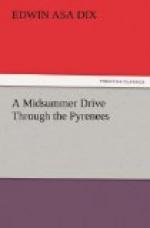[22] “Nous jugeons que l’immaculee Marie, mere de Dieu, a reellement apparu a Bernadette Soubirous, le 11 Fevrier, 1838, et jours suivants, au nombre de dix-huit fois, dans la grotte de Massabielle, pres la ville de Lourdes; que cette apparition revet tous les caracteres de la verite et que les fideles sont fondes a la croire certaine.”
The castle still stands, on a pointed hill above the town. Its founding goes back far beyond the days of its thieving English garrison; the Saracens once swarmed into it long before, flying before Charles the Hammer; and there is another story about it in this connection, as related by Inglis, which ends more happily than that of its murdered governor. Charlemagne, some years after the Saracens captured it, laid siege to recover it; surrender grew inevitable; but its Moorish commander, Mirat, though an infidel, was, for his nobility of character, in special favor with the Virgin,—Notre Dame de Puy.[23] In this extremity, she sent to him an eagle bearing in its beak a live fish; and Mirat promptly sent it to Charlemagne, to show his heavenly succor. The king, knowing that there was no possible fishing on the castle hill, perceived that it was a miracle; and lessening his rigor in the face of this sign, proposed less hard terms: the Moors were allowed to depart in safety, Mirat on his part agreed to be converted and become a good Catholic, and the castle was formally surrendered not to Charlemagne but to Notre Dame de Puy.
[23] Puy—St. Pe—is a shrine near Lourdes.
VIII.
But meanwhile we are moving toward Cauterets, not toward Lourdes. This part of the Lavedan valley is known as the “Eden of Argeles.” It expands about us in long, delicious levels; occasional eminences wrinkle its even lines; and the hills roll up from each side, rounded and gentle and often cultivated to their tops. Squares of yellow maize-fields chequer them, alternating with darker patches of pasture




